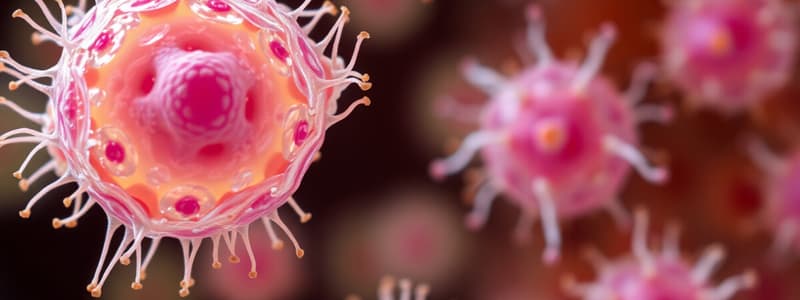Podcast
Questions and Answers
What is the primary function of chloroplasts in plant cells?
What is the primary function of chloroplasts in plant cells?
- Digestion of damaged cells
- Transport of materials within the cytoplasm
- Conversion of light energy to chemical energy (correct)
- Storage of nutrients
Which of the following statements about lysosomes is true?
Which of the following statements about lysosomes is true?
- They contain enzymes for photosynthesis.
- They transport materials within the cytoplasm.
- They store nutrients and release them as needed.
- They are involved in programmed cell death. (correct)
What is the role of peroxisomes in a cell?
What is the role of peroxisomes in a cell?
- Detoxify harmful molecules and breakdown hydrogen peroxide. (correct)
- Organize spindle fibers during mitosis.
- Support cell shape and structure.
- Store and release various substances.
What structure in animal cells helps organize spindle fibers during cell division?
What structure in animal cells helps organize spindle fibers during cell division?
Which cell organelle is primarily responsible for maintaining the cell's shape?
Which cell organelle is primarily responsible for maintaining the cell's shape?
What is the primary function of the cell membrane?
What is the primary function of the cell membrane?
Which part of the cell is primarily responsible for protein synthesis?
Which part of the cell is primarily responsible for protein synthesis?
What distinguishes smooth endoplasmic reticulum (SER) from rough endoplasmic reticulum (RER)?
What distinguishes smooth endoplasmic reticulum (SER) from rough endoplasmic reticulum (RER)?
Which component of the cell contains the chromatin materials?
Which component of the cell contains the chromatin materials?
What is the role of the Golgi apparatus in the cell?
What is the role of the Golgi apparatus in the cell?
How do mitochondria contribute to cellular respiration?
How do mitochondria contribute to cellular respiration?
What is the liquid portion found inside the nucleus called?
What is the liquid portion found inside the nucleus called?
Which statement correctly describes prokaryotic cells?
Which statement correctly describes prokaryotic cells?
Flashcards
Chloroplasts
Chloroplasts
Double-membraned organelles found in plant cells responsible for converting light energy into chemical energy during photosynthesis.
Lysosomes
Lysosomes
Single-walled membranous sacs that digest nutrients, bacteria, and damaged cells, playing a role in programmed cell death.
Peroxisomes
Peroxisomes
Spherical membranous vesicles containing enzymes that detoxify harmful molecules and break down amino acids.
Vacuoles
Vacuoles
Signup and view all the flashcards
Cytoskeleton
Cytoskeleton
Signup and view all the flashcards
Cell Membrane
Cell Membrane
Signup and view all the flashcards
Cytoplasm
Cytoplasm
Signup and view all the flashcards
Nucleus
Nucleus
Signup and view all the flashcards
Endoplasmic Reticulum (ER)
Endoplasmic Reticulum (ER)
Signup and view all the flashcards
Ribosomes
Ribosomes
Signup and view all the flashcards
Golgi Apparatus
Golgi Apparatus
Signup and view all the flashcards
Mitochondria
Mitochondria
Signup and view all the flashcards
Signup and view all the flashcards
Study Notes
Cell Structure and Function
- The human body is a community of cells
- Cells have three main components: cell membrane, cytoplasm, and nucleus
- The cell membrane is the outer layer, controlling what enters and exits the cell
- The cytoplasm is the living matter inside the cell, containing a jelly-like substance called hyaloplasm
- The nucleus, separated by a porous membrane, contains chromatin and nucleolus
- Eukaryotic cells have a nucleus and organelles, while prokaryotic cells do not
- Prokaryotic organisms include bacteria and cyanobacteria, while eukaryotic include protists, fungi, plants, and animals
- DNA in prokaryotic cells is a loop in the cytoplasm, while in eukaryotic cells DNA is organized into chromosomes
- RNA and proteins are synthesized in the same compartment in prokaryotic cells, but differently in eukaryotic cells
- Prokaryotic cells mainly lack cytoskeletons and organelles, while eukaryotic cells have both
- Prokaryotic cells mainly reproduce asexually, while eukaryotic cells reproduce sexually (mitosis and meiosis)
Parts and Functions (Animal Cells)
- Cell membrane: Outermost layer, regulating the entry and exit of substances
- Nucleus: Contains DNA and controls cellular activities
- Nuclear envelope: Surrounds the nucleus, containing nuclear pores
- Nucleolus: Located inside the nucleus, involved in ribosome production
- Peroxisome: Spherical vesicles with enzymes for detoxifying harmful molecules
- Lysosome: Single-walled sacs for digesting nutrients and damaged cells
- Golgi apparatus: Modifies, sorts, and packages materials for export
- Cytoplasm: Jelly-like substance containing organelles
- Ribosomes: Produce proteins
Cell Components and their functions
- Endoplasmic reticulum (ER): Network of membranes extending from the cell membrane to the nucleus
- Rough ER: Associated with protein synthesis
- Smooth ER: Involved in lipid synthesis and detoxification
- Ribosomes: Synthesize proteins; either free-floating or attached to rough ER
- Mitochondria: Double-walled sacs with folded inner membranes; release energy from food molecules
- Chloroplasts: (Plant cells only) Double-membrane organelles; convert light energy to chemical energy in photosynthesis
Support and Movement
- Cytoskeleton: Network of fibers (microtubules and microfilaments) maintaining cell shape and facilitating movement; includes centrosomes, cilia, and flagella
- Centrosomes: Organize spindle fibers during mitosis (animal cells only)
- Cilia and flagella: Hair-like projections for movement
Other Cell Components in Plant Cells
- Vacuoles: Membranous sacs storing and releasing substances, contributing to cell enlargement and water balance
- Cell wall: Rigid outer layer providing support and protection; made of cellulose
- Plasmodesmata: Channels between plant cells, facilitating communication
Differences Between Animal and Plant Cells
- Plant cells have cell walls, chloroplasts, and large central vacuoles; animal cells don't
- Plant cells are typically larger and more rectangular, animal cells smaller and have varied shapes
- Plant cells mainly reproduce asexually while animal cells reproduce in different ways
Studying That Suits You
Use AI to generate personalized quizzes and flashcards to suit your learning preferences.




